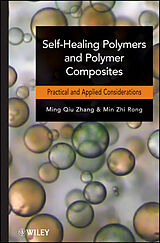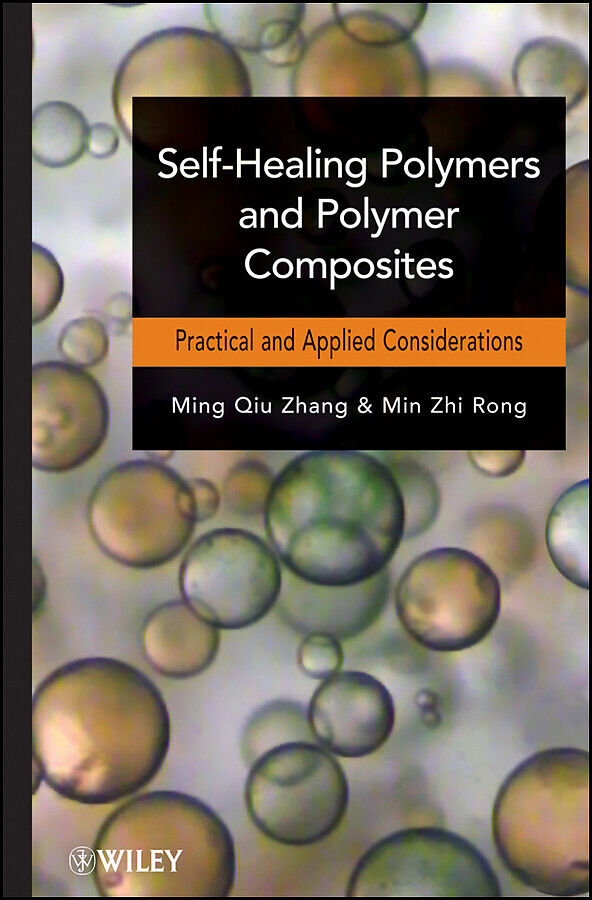Self-Healing Polymers and Polymer Composites
Einband:
E-Book (epub)
EAN:
9781118082584
Untertitel:
Englisch
Genre:
Chemie
Autor:
Ming Qiu Zhang, Min Zhi Rong
Herausgeber:
Wiley
Anzahl Seiten:
416
Erscheinungsdatum:
28.06.2011
ISBN:
978-1-118-08258-4
A state-of-art guide on the interdisciplinary aspects of design,
chemistry, and physical properties of bio-inspired self-healing
polymers
Inspired by the natural self-healing properties that exist in
living organisms--for example, the regenerative ability of
humans to heal from cuts and broken bones--interest in
self-healing materials is gaining more and more attention.
Addressing the broad advances being made in this emerging science,
Self-Healing Polymers and Polymer Composites incorporates
fundamentals, theory, design, fabrication, characterization, and
application of self-healing polymers and polymer composites to
describe how to prepare self-healing polymeric materials, how to
increase the speed of crack repair below room temperature, and how
to broaden the spectrum of healing agent species.
Some of the information readers will discover in this book
include:
* Focus on engineering aspects and theoretical backgrounds of
smart materials
* The systematic route for developing techniques and materials to
advance the research and applications of self-healing polymers
* Integration of existing techniques and introduction of novel
synthetic approaches and target-oriented materials design and
fabrication
* Techniques for characterizing the healing process of polymers
and applications of self-healing polymers and polymer
composites
* Practical aspects of self-healing technology in various
industrial fields, such as electronics, automotive, construction,
chemical production, and engineering
With this book, readers will have a comprehensive understanding
of this emerging field, while new researchers will understand the
framework necessary for innovating new self-healing solutions.
Autorentext
MING QIU ZHANG has over twenty-eight years of systematic
experience in polymers, polymer blends, and polymer composites. He
serves as a member of Asian-Australasian Association for Composite
Materials (AACM) Council and the standing council of Chinese
Society for Composites, as well as President of Guangdong Society
for Composites. In 1997, he received the prestigious fellowship
from the Natural Science Foundation of China for Outstanding Young
Scientists; and in 2005, the Li Ka Shing Foundation and the
Ministry of Education of China selected him as a Cheung Kong
Scholar. In addition, Professor Zhang is on the editorial board of
eight scientific journals and holds forty-three patents.
MIN ZHI RONG obtained his PhD degree in polymer chemistry
and physics in 1994 in Zhongshan University. Before that, he was a
researcher and lecturer in the Department of Materials Science and
Engineering, Tianjin University. His main interests are focused on
thermosetting/thermoplastic blends, polymeric functional materials,
structure of polymer networks, polymeric nanocomposites, natural
fiber composites, and self-healing of polymeric materials. Among
his many professional accolades, Professor Rong won the 2007 Prize
for Achievements in Natural Science Research for his work on
polymer nanocomposites awarded by the Ministry of Education of
China. Along with having been published in about 180 journal papers
and book chapters, Professor Rong also holds thirty-five
patents.
Zusammenfassung
A state-of-art guide on the interdisciplinary aspects of design, chemistry, and physical properties of bio-inspired self-healing polymers Inspired by the natural self-healing properties that exist in living organismsfor example, the regenerative ability of humans to heal from cuts and broken bonesinterest in self-healing materials is gaining more and more attention. Addressing the broad advances being made in this emerging science, Self-Healing Polymers and Polymer Composites incorporates fundamentals, theory, design, fabrication, characterization, and application of self-healing polymers and polymer composites to describe how to prepare self-healing polymeric materials, how to increase the speed of crack repair below room temperature, and how to broaden the spectrum of healing agent species. Some of the information readers will discover in this book include: Focus on engineering aspects and theoretical backgrounds of smart materials The systematic route for developing techniques and materials to advance the research and applications of self-healing polymers Integration of existing techniques and introduction of novel synthetic approaches and target-oriented materials design and fabrication Techniques for characterizing the healing process of polymers and applications of self-healing polymers and polymer composites Practical aspects of self-healing technology in various industrial fields, such as electronics, automotive, construction, chemical production, and engineering With this book, readers will have a comprehensive understanding of this emerging field, while new researchers will understand the framework necessary for innovating new self-healing solutions.
Inhalt
Preface. 1 Basics of Self-Healing: State of the Art. 1.1 Background. 1.1.1 Adhesive Bonding for Healing Thermosetting Materials. 1.1.2 Fusion Bonding for Healing Thermoplastic Materials. 1.1.3 Bioinspired Self-Healing. 1.2 Intrinsic Self-Healing. 1.2.1 Self-Healing Based on Physical Interactions. 1.2.2 Self-Healing Based on Chemical Interactions. 1.2.3 Self-Healing Based on Supramolecular Interactions. 1.3 Extrinsic Self-Healing. 1.3.1 Self-Healing in Terms of Healant Loaded Pipelines. 1.3.2 Self-Healing in Terms of Healant Loaded Microcapsules. 1.4 Insights for Future Work. References. 2 Theoretical Consideration and Modeling. 2.1 Molecular Mechanisms. 2.1.1 Self-Healing Below Glass Transition Temperature. 2.1.2 Self-Healing Above Glass Transition Temperature. 2.2 Healing Modeling. 2.2.1 Percolation Modeling. 2.2.2 Continuum and Molecular-Level Modeling of Fatigue Crack Retardation. 2.2.3 Continuum Damage and Healing Mechanics. 2.2.4 Discrete Element Modeling and Numerical Study. 2.3 Design of Self-Healing Composites. 2.3.1 Entropy Driven Self-Assembly of Nanoparticles. 2.3.2 Optimization of Microvascular Networks. 2.4 Concluding Remarks. References. 3 Extrinsic Self-Healing via Addition Polymerization. 3.1 Design and Selection of Healing System. 3.2 Microencapsulation of Mercaptan and Epoxy by in situ Polymerization. 3.2.1 Microencapsulation of Mercaptan. 3.2.2 Microencapsulation of Epoxy. 3.3 Characterization of Self-Healing Functionality. 3.3.1 Self-Healing Epoxy Materials with Embedded Dual Encapsulated Healant: Healing of Crack Due to Monotonic Fracture. 3.3.2 Factors Related to Performance Improvement. 3.3.3 Self-Healing Epoxy Materials with Embedded Dual Encapsulated Healant: Healing of Fatigue Crack. 3.3.4 Self-Healing Epoxy/Glass Fabric Composites with Embedded Dual Encapsulated Healant: Healing of Impact Damage. 3.4 Concluding Remarks. References. 4 Extrinsic Self-Healing via Cationic Polymerization. 4.1 Microencapsulation of Epoxy by UV Irradiation-Induced Interfacial Copolymerization. 4.2 Encapsulation of Boron-Containing Curing Agent. 4.2.1 Loading Boron-Containing Curing Agent onto Porous Media. 4.2.2 Microencapsulation of Boron-Containing Curing Agent via Hollow Capsules Approach. 4.3 Characterization of Self-Healing Functionality. 4.3.1 Self-Healing Epoxy Materia…

Leider konnten wir für diesen Artikel keine Preise ermitteln ...
billigbuch.ch sucht jetzt für Sie die besten Angebote ...
Die aktuellen Verkaufspreise von 6 Onlineshops werden in Realtime abgefragt.
Sie können das gewünschte Produkt anschliessend direkt beim Anbieter Ihrer Wahl bestellen.
Loading...
Die aktuellen Verkaufspreise von 6 Onlineshops werden in Realtime abgefragt.
Sie können das gewünschte Produkt anschliessend direkt beim Anbieter Ihrer Wahl bestellen.
| # | Onlineshop | Preis CHF | Versand CHF | Total CHF | ||
|---|---|---|---|---|---|---|
| 1 | Seller | 0.00 | 0.00 | 0.00 |
